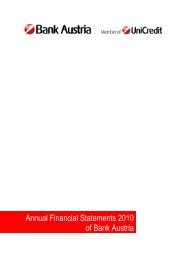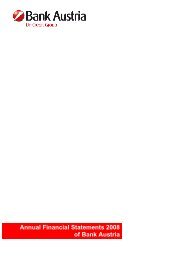Annual Financial Statements 2011 of Bank Austria
Annual Financial Statements 2011 of Bank Austria
Annual Financial Statements 2011 of Bank Austria
You also want an ePaper? Increase the reach of your titles
YUMPU automatically turns print PDFs into web optimized ePapers that Google loves.
Consolidated <strong>Financial</strong> <strong>Statements</strong> in accordance with IFRSs<br />
E – Risk report (CoNTINuED)<br />
CEE<br />
The favourable trend in net write-downs <strong>of</strong> loans and provisions for guarantees and commitments seen at the subsidiaries in CEE in 2010 continued<br />
in <strong>2011</strong>. The provisioning charge declined to about € 1,055 m (2010: € 1,426 m).<br />
While net write-downs <strong>of</strong> loans and provisions for guarantees and commitments in 2010 showed a very favourable trend especially in the second<br />
half <strong>of</strong> the year, <strong>2011</strong> saw a positive development throughout the year. The figure for each quarter was significantly lower than that for the comparative<br />
period in 2010; the downward trend was most pronounced in the second quarter <strong>of</strong> <strong>2011</strong>, with € 246 m (2010: € 324 m), and in the fourth<br />
quarter, with € 296 m (2010: € 449 m).<br />
A regional analysis shows that as in the previous year, the provisioning charge further declined especially in the difficult CIS region, where it fell to<br />
€ 442 m (2010: € 719 m). The strong decline in net write-downs <strong>of</strong> loans and provisions for guarantees and commitments in <strong>2011</strong> was mainly<br />
driven by Kazakhstan with a provisioning charge <strong>of</strong> € 282 m 2) (2010: € 425 m), Russia with € 60 m (2010: € 138 m) and Ukraine with € 100 m<br />
(2010: € 156 m). Nevertheless, the repercussions <strong>of</strong> the crisis in this region should not be underestimated: in Kazakhstan, the real estate sector<br />
and the construction industry remained under pressure, and in Ukraine the difficult political climate was also a significant factor.<br />
On the positive side, it should also be mentioned that the Baltic states and Romania, which were the main drivers <strong>of</strong> the provisioning charge in the<br />
previous year, recovered from the crisis, recording a significant decline in net write-downs <strong>of</strong> loans and provisions for guarantees and commitments<br />
in <strong>2011</strong>, to € 9 m 3) (2010: € 65 m) and € 85 m 4) (2010: € 115 m), respectively.<br />
On the negative side, net write-downs <strong>of</strong> loans and provisions for guarantees and commitments in Hungary were up by € 15 m on the previous<br />
year, reaching € 95 m in <strong>2011</strong> mainly as a result <strong>of</strong> the Early Repayment Programme (ERP) introduced by the Hungarian government. Before the<br />
ERP was announced, the provisioning charge was expected to be significantly lower than in the previous year. The country’s unforeseeable fiscalpolicy<br />
rules and a partial loss <strong>of</strong> credibility in financial markets are significant factors in Hungary.<br />
Impaired loans and the impaired loans ratio (impaired loans as a percentage <strong>of</strong> total loans to customers) at the CEE banking subsidiaries in the<br />
<strong>2011</strong> financial year showed a continued increase over the previous year. A significant portion <strong>of</strong> the increase is due to a methodological change in<br />
the classification <strong>of</strong> impaired loans in the first quarter. The new classification (five risk classes instead <strong>of</strong> previously three) – a change required by<br />
<strong>Austria</strong>’s central bank and by Banca d’Italia, Italy’s central bank – creates a standard framework for all CEE units but resulted in an increase <strong>of</strong><br />
€ 848 m in impaired loans. Based on the “real risk trend” (i.e. if the original classification is used for the calculation), impaired loans would have<br />
increased by € 849 m instead <strong>of</strong> the actual € 1,697 m. On this basis, impaired loans in the <strong>2011</strong> financial year as a whole would have increased<br />
at a significantly lower rate, by 40 bp to 14.0%, rather than the actual 165 bp.<br />
Kazakhstan and Ukraine were again the main drivers in <strong>2011</strong> while the Baltic states (one <strong>of</strong> the main drivers in 2010) recorded a marked decline.<br />
Another positive feature was the recovery in Turkey and Russia in the area <strong>of</strong> impaired loans, with the impaired loans ratio further declining<br />
compared with the previous year.<br />
Mortgages are the main type <strong>of</strong> collateral used; other types <strong>of</strong> collateral accepted are guarantees and suretyships.<br />
Credit risk methods and instruments<br />
Very important factors in the credit approval process are a detailed assessment <strong>of</strong> risk associated with each loan exposure, and the customer’s<br />
credit rating in particular. Every lending decision is based on a thorough analysis <strong>of</strong> the loan exposure, including an evaluation <strong>of</strong> all relevant factors.<br />
Following the initial loan application, the bank’s loan exposures are reviewed at least once a year. If the borrower’s creditworthiness deteriorates<br />
substantially, shorter review intervals are obligatory.<br />
For internal credit assessment in <strong>Austria</strong> and by <strong>Bank</strong> <strong>Austria</strong>’s banking subsidiaries in CEE, the bank uses various rating and scoring models – for<br />
calculating the parameters PD (probability <strong>of</strong> default), LGD (loss given default) and EAD (exposure at default) – on the basis <strong>of</strong> models specifically<br />
developed for these purposes for the customer/ business segments to be assessed, in line with the various asset classes pursuant to Section 22b<br />
<strong>of</strong> the <strong>Austria</strong>n <strong>Bank</strong>ing Act, the Solvency Regulation and Directive 2006/48/EC <strong>of</strong> the European Parliament and <strong>of</strong> the Council <strong>of</strong> 14 June 2006<br />
relating to the taking up and pursuit <strong>of</strong> the business <strong>of</strong> credit institutions. There are country-specific or region-specific models (e.g. for corporate<br />
customers, private and business customers) and global models (e.g. for sovereigns, banks, multinational corporates). The assessment <strong>of</strong> a loan<br />
exposure is based on data from the respective company’s financial statements and on qualitative business factors.<br />
2) Of which € 110 m booked locally and € 172 m booked in Vienna.<br />
3) Of which € 5 m booked locally and € 4 m booked in Vienna.<br />
4) In addition, € 21 m provisions for guarantees were booked for loans transferred to Vienna.<br />
<strong>Bank</strong> <strong>Austria</strong> · <strong>Annual</strong> <strong>Financial</strong> <strong>Statements</strong> <strong>2011</strong><br />
152
















